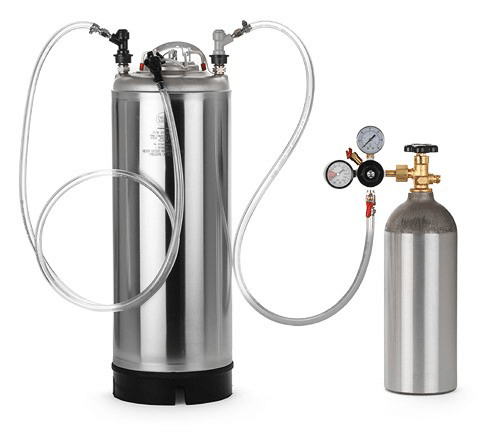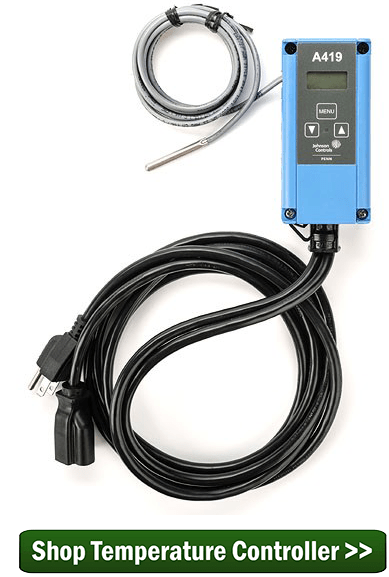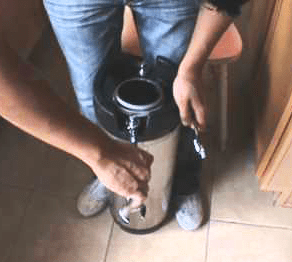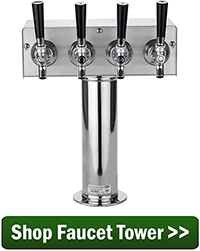 One of the best parts of kegging your homebrew is that you don’t have to bother with beer bottles and priming sugar. You can force carbonate the beer by pushing CO2 gas directly into it. This blog post will cover three methods for carbonating a homebrew keg.
One of the best parts of kegging your homebrew is that you don’t have to bother with beer bottles and priming sugar. You can force carbonate the beer by pushing CO2 gas directly into it. This blog post will cover three methods for carbonating a homebrew keg.
Assuming that you’ve already cleaned, sanitized, and filled your homebrew keg, you are now ready to carbonate. Check out these carbonation methods that show you how to carbonate through both force carbonation, including shaking the keg, and through natural carbonation. Pick out the best way to carbonate for you and your situation.
Method #1: Steady as She Goes
This method of force carbonating a homebrew keg is the most hands-off. Expect your beer to be ready in about five days.
- Determine how much carbonation you want in your beer (refer to this carb calculator). When in doubt, aim for about 2.3-2.5 volumes of CO2.
- Figure out how much CO2 pressure is needed to reach your desired carbonation. This will depend on the temperature of your homebrew while it is carbonating. Refer to this carb calculator.
- With all valves closed, connect the CO2 tank to the regulator, and the regulator to the gas-in post on the keg.
- Open valves and set the regulator to the desired psi level.
- After four or five days, take a sample of beer. If the beer needs more carbonation, give it an extra day or two. If the beer is over carbonated, you can “bleed off” pressure by pulling on the pressure relief valve.
- Your beer is ready to drink! Reduce pressure to about 10 psi to serve.
Method #2: Shake and Bake
 This is the accelerated way of force carbonate a homebrew keg. While faster, the results are more unpredictable.
This is the accelerated way of force carbonate a homebrew keg. While faster, the results are more unpredictable.
- Determine how much carbonation you want in your beer (refer to carb calculator). When in doubt, aim for about 2.3-2.5 vols CO2.
- Figure out how much CO2 pressure is needed to reach your desired carbonation. This will depend on the temperature of your beer. Refer to this carb calculator.
- With all valves closed, connect the CO2 tank to the regulator, and the regulator to the beer-out post on the keg.
- Open valves and set regulator to 20-30 psi. You should hear CO2 bubble through the beer.
- Shake the keg for about five minutes.
- Remove the CO2 quick disconnect and vent the keg. Repeat this process several times over the course of a day.
- Reset the regulator to the psi level you found in step 2 and reconnect the CO2 quick disconnect to the gas-in post.
- Take a sample of the homebrew. If the beer needs more carbonation, continue to shake and bake. If the homebrew is over carbonated, you can “bleed off” pressure by pulling on the pressure relief valve.
- Your beer is ready to drink! Set the pressure to about 10 psi for serving. Depress fully on the tap to avoid foaming.
Method #3: The Old Fashioned
 If you’re short on gas or you want your beer to be “cask style”, you can also carbonate your keg using priming sugar. When you are carbonating a homebrew keg with sugar, this is known as natural carbonation. It will take longer than force carbonation, but it’s relatively straightforward and predictable. In this case, you can mix in the priming sugar when you fill your homebrew keg with beer.
If you’re short on gas or you want your beer to be “cask style”, you can also carbonate your keg using priming sugar. When you are carbonating a homebrew keg with sugar, this is known as natural carbonation. It will take longer than force carbonation, but it’s relatively straightforward and predictable. In this case, you can mix in the priming sugar when you fill your homebrew keg with beer.
- Determine how much carbonation you want in your beer (refer to carb calculator). When in doubt, aim for about 2.3-2.5 vols CO2.
 Use a priming sugar calculator to determine how much corn sugar or DME you need.
Use a priming sugar calculator to determine how much corn sugar or DME you need.- Heat about a pint of water in a saucepan and dissolve your priming sugar. Mix in your priming sugar and bring to a boil. Set aside to cool.
- Once cooled to room temperature, pour into your clean and sanitized homebrew keg.
- Rack your homebrew from the fermenter to the keg.
- Seal the keg. Take extra care to get a good seal on the lid and posts. Keg lube can help.
- Leave the keg in a room temperature environment at about 70˚F. After about two weeks, your beer will be ready to drink!
- You’ll still need CO2 to serve your beer. Set the regulator pressure to about 10 psi for serving.
What method do you use for carbonating a homebrew kegs? Which of the methods above do you think is the best way to carbonate.
———————————–
David Ackley is a beer writer, brewer, and self-described “craft beer crusader.” He holds a General Certificate in Brewing from the Institute of Brewing and Distilling and is founder and editor of the Local Beer Blog.

I had some problems with my floating dip tube and lost my gas, wondered if I could simply add more sugar and recarbonate. Hey presto, it worked! Now I wonder if you keep doing it indefinitely until the keg is completely served?